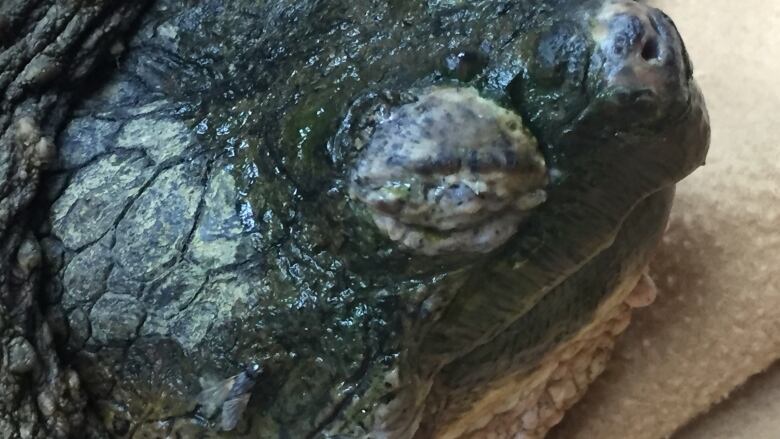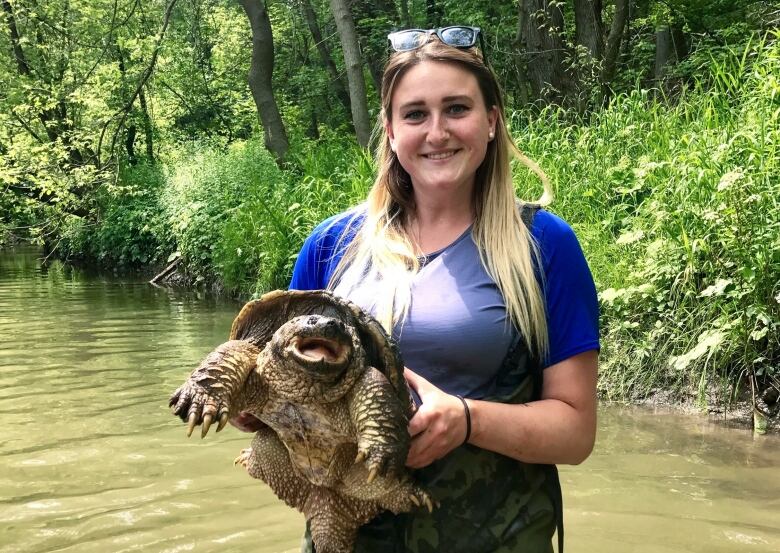Virus that has contributed to 'mass mortality' in reptiles confirmed in Canadian turtle for 1st time
'All of our turtle species in Ontario are, to some degree or other, under threat'

A strain of virus that has contributed to "mass-mortality events" in fish, frogs and salamanders has been confirmed in a Canadian reptile for the first time.
Ranaviruscauses lesions to open on the face and neck and swelling of internal organs. This straingenerally leads to organ failure and death within four weeks, according toMorganPiczak, a masters of science candidate at McMaster University.
It has previously been found in Canadian amphibians, but never a reptile.
When Piczakpulled ahefty snapping turtle from the water at Cootes Paradise, a wetland in Hamilton, last year she could immediately tell something was wrong.
"The skin on the head is normally a dark brown or dark green, but it was very white and there was extreme swelling of the eyes, so much so we couldn'teven see one of the eyes," said the masters of science candidate fromMcMaster University. "The swelling,discoloration and lesions continued down toward theneck."

Theturtle was taken to the vet, but died less than 24 hours later, according to Piczak, who added the discovery was especiallyupsetting because she estimates the turtle was more than 50 years old.
"He may have passed all odds and survived to such an old age and then for him to succumb to this disease was really sad."
DNA tests confirm virus
After the reptile died, it was sent to the Ontario Veterinary College for further study.
Pathologist Doug Campbell said samples from the turtle were then transported to a lab in British Columbia where the reptile's DNA was tested and the presence of ranavirus confirmed as the first-ever case in a snapping turtle.
There is no cure.- Morgan Piczak, McMaster University
"The significance to me is that it demonstrates it truly is a virus that's capable of causing serious disease in turtles," he said.
Campbell said it's also possible ranavirus has been in Canada for some time, but the college has mostly studied turtles that have suffered trauma, not sickness, so it may have gone unnoticed.
"All of our turtle species in Ontario are, to some degree or other, under threat."
That threat is especially worrisome, as turtle speciesare already struggling in Canada, so any new danger is sure to be of concern, he added.
Second sick turtle found
Two weeks ago, while tracking her first turtle of the year, Piczak said she came across another male snapper with the same swelling and sores.
"That was particularly disturbing because right now is when snapping turtles are mating so that's when their contact is highest," she explained.
It's not known how the virus is transmitted, but the scientist said the fact turtles interact with environments both on land and in the water and live in close quarters with other creatures including frogs, fish and other turtle species raises worries about a wider outbreak.

"The best we can do is hopefully find that individual and remove them from the environment," she said. "Right now there is no cure."
Campbell said the discovery comes with a lot of unanswered questions. Where did the virus come from? How has it survived?
He added the only way for scientists to learn more is if people start reporting turtle sightings, so they can be further studied.
"Turtles are somewhat a neglected species, a lot of people take them for granted," he said. "If you see a sick turtle or find a turtle that's dead it would be well worth it to have someone look at it."
- MORE HAMILTON NEWS |'Weather is changing' and Hamilton emergency officials want you to be prepared
- MORE HAMILTON NEWS |New survey aims to strengthen relationship between city and Indigenous community












_(720p).jpg)


 OFFICIAL HD MUSIC VIDEO.jpg)
.jpg)



























































































